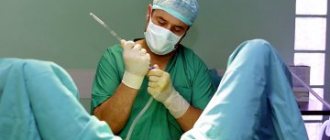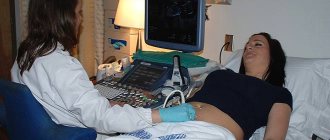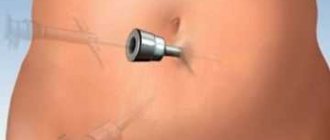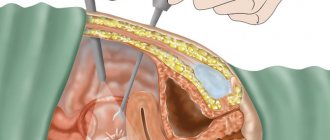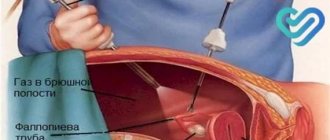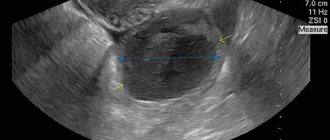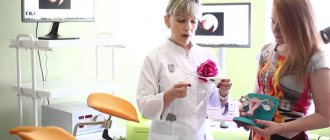Faced with infertility, many people cannot find out the reasons why pregnancy does not occur for a long time. They remain unclear even after examining both partners. Laparoscopy is a modern method of identifying and eliminating pathologies of the internal genital organs. It is carried out for therapeutic and diagnostic purposes. But since this is a minimally invasive operation, women still have doubts about the feasibility and safety of its implementation.
Is it worth doing laparoscopy for infertility?
The inability to have children can be primary in nature, when the woman was not previously pregnant, and secondary, if after childbirth the patient cannot conceive again as a result of injury, abortion, or inflammatory diseases. It often happens that it is difficult to make an accurate diagnosis. In this case, doctors note infertility of unknown origin.
The international diagnostic algorithm includes mandatory endoscopic examination in the treatment of infertility - laparoscopy. This minimally invasive operation can solve many women’s health problems, such as:
- adhesions,
- cysts and neoplasms,
- obstruction of the fallopian tubes,
- endometriosis,
- polyps.
All this can cause primary and secondary infertility.
Laparoscopy is a unique method of surgical intervention, as a result of which a woman’s fertile function is restored and preserved. It should not be done without special indications.
But when it has been impossible to conceive for several years, and there are no apparent reasons for this, then laparoscopy helps to find out the nature of infertility, understand the degree of damage and find out the prospects. In more than 80% of patients, it helps to determine the cause of infertility of unknown origin. Laparoscopy is a mandatory step in IVF.
We recommend reading about pregnancy after hysteroscopy. From the article you will learn about the essence of the procedure, the course of its implementation, the problems that it solves, the advantages, as well as why hysteroscopy and laparoscopy are prescribed at the same time and when you can plan a pregnancy after.
And here is more information about laparoscopy in early pregnancy.
Signs of a normal process
The healing process of sutures may be accompanied by the following clinical picture, which often becomes a cause of concern for the patient:
- the wounds hurt with an aching character;
- moisture in the wound surface;
- abdominal bloating;
- compaction formed under the seam;
- itching
The listed signs are a normal reaction to scar healing and restoration of the skin. Thus, new flesh grows.
Survey objectives
This minimally invasive examination can be performed as an independent diagnostic or therapeutic operation, or in conjunction with vaginal interventions and hysteroscopy.
After surgery, a woman does not need a long time for recovery and rehabilitation, and there is also no risk of organ injury that could worsen the condition. But laparoscopy is prescribed only when all conservative methods have been tried.
Diagnostic for infertility of unknown origin
For this purpose, special optical instruments are used. The main advantage of the method is that if pathologies were identified during the diagnostic examination, they are immediately eliminated. Repeated surgery is not necessary. It also makes it clear whether secondary and further treatment is needed and whether it will be successful.
Laparoscopy reveals even minor changes in the anatomy of the genital organs. During the procedure, doctors see an enlarged picture in the smallest detail on the monitor, which allows them to correct the pathology with pinpoint precision. With conventional abdominal surgery such confidence and safety are not possible.
Operational
This type of laparoscopy is the second stage in the treatment of infertility. Once the causes are identified, they need to be eliminated. Conventional conservative methods, medications or abdominal surgery in some cases will not give results, and can even lead to major complications. It is performed under general anesthesia. Surgical laparoscopy helps solve the following causes of infertility:
- Adhesions in the pelvic organs. These are thin thread-like formations that interfere with the normal functioning of organs. Adhesions most often occur in the tubes and prevent the egg from moving into the uterine cavity. Also, these formations can displace organs and prevent them from sliding freely. As a result, their work is disrupted.
However, although laparoscopy can help eliminate adhesions, they appear again. The guarantee of a successful 100% cure in this case is no more than 4 - 5%. Doctors usually advise performing IVF immediately.
- Endometriosis. Endometrial cells outside the uterine cavity lead to the formation of adhesions. In addition, the affected endometrium is not able to participate in egg implantation. Endometriosis is also often accompanied by ovarian cysts and polyps in the uterine cavity. This pathology is eliminated at the initial stage using laparoscopy.
- Cysts . Education in the ovaries occurs for various reasons. It can be functional or organic. The latter must be removed as quickly as possible, since a malignant process in the cyst cannot be ruled out, and this may well threaten the patient’s life.
- A benign tumor is uterine fibroids . Often, at the beginning of its development, it does not make itself felt in any way, so it seems possible to detect it only by laparoscopy. It occurs mainly due to hormonal imbalances. Symptoms become obvious only when the fibroid has grown and now disrupts the cycle, interferes with ovulation and gestation, and therefore reduces the chances of conception.
- Obstruction of the fallopian tubes. The onset of pregnancy directly depends on their healthy functioning. If there is a malfunction, sperm cannot reach the female reproductive cell, and the fertilized egg cannot penetrate the uterine cavity. Therefore, it is very important not to injure the pipes.
Thus, laparoscopy increases the chances of spontaneous conception, and also improves a woman’s health and reduces the risks of pregnancy after IVF.
Control
This type of minimally invasive surgery is performed quite rarely. Control laparoscopy is necessary only to determine the consequences after treatment. Prescribed in extremely severe cases when other types of diagnostics cannot provide a reliable answer.
What's better?
Laparoscopy and hysteroscopy cannot be called interchangeable procedures. They have completely different execution techniques, but can sometimes pursue similar goals. As a rule, doctors do not allow the patient to independently choose between these procedures. And they are prescribed based on serious indications identified in a particular patient. It is the doctor who decides which method is best in each specific case.
So, during hysteroscopy, the doctor can do an endometrial biopsy or remove the remains of the fertilized egg from the uterus. This is completely impossible to do with laparoscopy, since the instruments are located in the peritoneum and do not enter the reproductive organ. During laparoscopy, it is possible to cut connective tissue cords, perform an oophorectomy, or remove an ectopic pregnancy. What a hysteroscope cannot always cope with.
Sometimes doctors decide to combine laparoscopy and hysteroscopy. In this case, specialists have expanded opportunities; they can comprehensively study the pathology and take the necessary measures to eliminate it.
Preparing for surgery
Despite the fact that laparoscopy is a minimally invasive operation, it requires a certain preparatory stage. During the month before surgery, taking hormonal contraceptives is prohibited. As a rule, laparoscopy is prescribed a day or two after the start of menstruation.
Before the procedure, the patient must undergo the following tests:
- blood (general and biochemical);
- coagulogram;
- tests for syphilis, HIV, hepatitis B and C;
- find out blood type and Rh factor;
- vaginal smear for microflora;
- bacteriological culture from the cervical canal;
- ultrasound examination of the pelvic floor organs;
- electrocardiogram;
- fluorography.
All tests must be no older than 10 days before surgery. Using them, doctors will be able to understand whether a woman has any contraindications to laparoscopy. The operation is not performed for infectious diseases, exacerbation of chronic diseases, and special attention is paid to indications for obesity, over the age of forty years, and for diseases of the heart and blood vessels.
Thorough preparation requires cleansing the body and gastrointestinal tract, which includes the following activities:
- The patient must report all medications she is taking and stop taking them seven days before surgery.
- You should exclude baked goods, fruits, legumes, sweets, milk, and starchy vegetables from your diet for a week before laparoscopy.
Dietary restrictions before surgery
- For five days, start taking activated carbon, two tablets in the morning, afternoon and evening. It can be replaced with Mezim, Pancreatin, Festal.
- An enema is performed in the evening the day before the operation and another one in the morning before the intervention.
- The day before, you should not eat heavy or solid food for lunch, only liquid food. And for dinner you can only drink. On the day of the operation you should not eat or drink.
- Immediately before laparoscopy, the patient should take a shower and shave the hair below the navel and in the groin area.
- For those who are very worried about the operation, doctors can prescribe herbal sedatives such as motherwort and valerian.
Drinking and smoking are prohibited before surgery.
In rare cases, a consultation with a psychotherapist is required before laparoscopy. In addition, on the eve of laparoscopy, the patient talks with the anesthesiologist. The woman fills out a special questionnaire about her health status, in which she indicates whether she is allergic to certain medications, the state of her cardiovascular system, whether she plays sports, or whether she has bad habits. The anesthesiologist must know about previous operations.
If you have any questions, now is the right time to ask. At the end, the patient signs consent for surgery and anesthesia. Based on the results of the conversation, the doctor calculates the dose and time of anesthesia.
Laparoscopy of the fallopian tubes: postoperative p..
The laparoscopy method is used to diagnose and treat diseases of the reproductive organs.
A diagnostic operation is performed to check the patency of the fallopian tubes, during ovarian resection, ectopic pregnancy and many other pathologies.
If fallopian tube laparoscopy is performed, the postoperative period after it is practically no different from other types of endoscopic operations. Let's consider how you need to behave and what you can eat after laparoscopy of the fallopian tubes.
Typically, an endoscopic examination of the fallopian tubes is prescribed when pathologies are detected (hydrosalpings, pyosalpinx), adhesions, or to check patency.
Of course, other diseases of the reproductive organs can be detected in the process, for example, ovarian cysts and foci of endometriosis.
Their removal, like removal of the fallopian tube, also affects the patient’s condition, but laparoscopy itself is a minimally invasive intervention.
The first hours after surgery
Already 5-6 hours after laparoscopy, the patient can get out of bed if the anesthesiologist allows and always in the presence of medical staff to prevent dizziness or falling. The patient is allowed to get up slowly and go to the toilet. She will have discomfort in her throat for some time due to the endotracheal tube used for inhalation anesthesia.
In the first hours after surgery, you can drink, preferably plain water, as nausea and vomiting may occur. After 5-6 hours, you can drink a glass of kefir, broth or eat yogurt.
Recovery period after laparoscopy
On the second day, you should limit yourself to light, preferably pureed soups in chicken or vegetable broth; natural juices and fermented milk products are allowed. The diet after tubal laparoscopy on days 3-5 consists of boiled or steamed foods. It is necessary to exclude fried, spicy, gas-forming foods (flour, sweets, fresh vegetables and fruits).
Nausea, vomiting, bloating, lack of stool 2-3 days after laparoscopy indicate intestinal paresis and impaired passage of food masses. You should definitely consult a doctor who will prescribe intestinal stimulation. Stimulation after laparoscopy is carried out with the help of medications to increase the tone of the intestinal muscles, in some cases an enema is prescribed.
If inflammatory processes and adhesions were detected during laparoscopy, then physiotherapy is prescribed after it, which speeds up recovery, reduces pain, and prevents the formation of adhesions. Magnetic therapy after laparoscopy of the fallopian tubes has a good effect. Prescribe 10-15 sessions of 20 minutes each.
It is important for the patient after endoscopic intervention to provide adequate pain relief so that she can walk, this also prevents the formation of adhesions. You need to try not to get too cold and limit physical activity.
It is better to postpone training in the gym for 3-4 weeks, and even after that gradually increase the load. It is dangerous to lift weights in the first days after surgery, meaning weights exceeding 3-4 kg.
Menstruation after laparoscopy
Menstruation after laparoscopy may be delayed or, conversely, begin prematurely; this is a normal phenomenon associated with operational stress. The discharge may be scanty or abundant. Sexual activity is allowed after 2-3 weeks, in the absence of pain.
Caring for wounds involves lubricating them with brilliant green or alcohol, unless the doctor advises something else.
The sutures are removed on days 7-10, during which time it is advisable not to wet them, and after removing the sutures, be careful when swimming, but use a hard washcloth and treat the scar after water procedures with brilliant green until complete healing. If there is redness, swelling, tenderness or discharge, consult a doctor.
You should also consult your doctor if your temperature rises above 38 degrees, severe abdominal pain, weakness, dizziness, or loss of consciousness. These may be signs of an inflammatory process in the abdominal cavity.
Despite the fact that the recovery period after laparoscopy is short, we must not forget that this is a surgical intervention and it can lead to complications, so you must follow all the recommendations of your doctor.
Diet after laparoscopy
Proper nutrition after surgery allows a woman to recover faster, feel better during the postoperative period and reduce the risk of complications. Therefore, all patients must be given recommendations regarding diet after tubal laparoscopy.
Basic recommendations:
Drinking regime
There should be a lot of water. You need to drink at least one and a half liters per day. The preferred drink is water. If it is compote or other liquid, then it is desirable that it does not contain added sugar. In this case, there will be fewer intestinal problems.
Water is of utmost importance in the nutritional regimen after tubal laparoscopy. As, indeed, after any other operation. Because it normalizes metabolic processes, allows the body to better regulate temperature and removes toxic substances.
Of course, it is possible to ensure the required volume of fluid in the body after surgery without nutrition. For example, using droppers. But drinking water is more pleasant and cheaper. In addition, it is more physiological.
Meat broths
An important component of dietary recommendations. Laparoscopy of the fallopian tubes disrupts digestion. Intestinal motility worsens, and the production of digestive juices may decrease. Therefore, it is difficult for the body to digest complete protein foods after surgery.
But the surgery always damages the tissue. Protein is required to restore them. Therefore, it must be obtained in a lighter form.
In the first days after surgery, patients are advised to prepare and consume meat broth. It is essentially an amino acid solution.
From the resulting amino acids, the body will synthesize proteins - “building blocks”, which are used to restore damaged tissues.
Meat broth is rich in lysine and proline. These amino acids play an important role in neurotransmitter mechanisms.
You can add onions to the broth - it will not only make it tastier, but will also bring additional benefits, because onions are an additional source of vitamin C. Ascorbic acid takes part in the oxidation of proline into hydroxyproline.
It promotes the formation of a stronger and more stable collagen molecule, the main material for scar formation.
The broth should be salty. Electrolytes are necessary for the body after surgery to restore water and mineral metabolism.
At the same time, the broth should not be fatty. It is better not to cook it from pork, lamb or beef, or waterfowl meat. You should prefer chicken, rabbit, turkey or lean veal. The body has a hard time dealing with fats after surgery. Digesting them requires intensive work of the pancreas, the function of which may be temporarily impaired.
Dairy
They are an additional source of proline. In addition, they contain calcium. It takes part in the acetylation and oxidation of nutrients (fats, carbohydrates).
Rose hip decoction
As an alternative option - compotes, fruit drinks. If you have made compote from fruits or berries, you should strain it. Such decoctions are rich in vitamins. They contain fruit acids that stimulate intestinal function. Drinking these drinks can whet your appetite.
Plus, they taste better than water. As we have already found out, after laparoscopy of the fallopian tubes you need to drink a lot to ensure full recovery of the body. When drinking compote, women usually show more enthusiasm. Therefore, there is a greater chance that the drinking regime after surgery will be observed to the required extent.
Liquid porridge
They are the main source of energy for the recovery period. As we have already said, any operation disrupts digestion. But digesting carbohydrates requires minimal effort on the part of the body.
Glucose is absorbed without any preliminary enzymatic treatment at all.
Starch is broken down into glucose by the action of amylase, which is produced in almost all organs of the digestive system, including the mouth.
Carbohydrates are easily and quickly absorbed. Therefore, all women after laparoscopy of the fallopian tubes are given liquid porridge from the following cereals:
These are the most preferred options. Although eating other cereals is also not prohibited. They need to be cooked with plenty of water. Such nutrition is well tolerated and gives the body strength to recover.
The listed porridges, especially buckwheat, are good because they contain a large amount of B vitamins. They are very important after any operation. Often doctors even prescribe vitamins in injections. But it is, of course, more pleasant to receive them with food.
Functions of the main vitamins contained in cereals:
- B1 – helps convert received nutrients into energy;
- B2 – improves the functions of the mucous membranes, helps to form hemoglobin (which is important, given that laparoscopy of the fallopian tubes does not occur without blood loss);
- B3 – takes part in protein synthesis, and this is necessary for tissue regeneration;
- B5 – improves the condition of blood vessels and releases energy from food.
Iron-containing products
After laparoscopy of the fallopian tubes, blood loss is much less than during open surgery. However, they still exist.
Once the body loses a certain amount of blood, it cannot restore it instantly. More water is simply introduced into the vascular bed. Therefore, the concentration of blood cells, in particular red blood cells, becomes lower.
Gradually they will be produced in the body. But this requires iron. If there is not enough of it in the body, the resulting red blood cells will be defective. The hemoglobin concentration in the blood will decrease.
To prevent this from happening, a woman needs additional sources of iron. If she does not have anemia, then iron supplements are not prescribed after surgery. The required amount of this microelement can be obtained from food. To do this, you need to consume any products that:
- are of animal origin;
- red for color.
Blood sausage contains the most iron. Although not everyone likes it, and it is not always available for sale. But there are many alternative products: salmon, trout, red meats, liver.
Many women have heard that iron is also found in vegetables. They ask their doctors why not, instead of meat, to replenish the iron deficiency after surgery, for example, with apples or pomegranates. They are also red in color and are considered healthier.
In fact, plant foods are less preferable in this regard, because they contain:
- less iron;
- it is of poorer quality (non-heme).
This is why vegetarians often develop anemia. If you are one of them, it is better to temporarily, for the period after the operation, abandon your beliefs. If this is not possible, iron supplements may be an alternative.
What foods are contraindicated?
It is undesirable to eat after laparoscopy:
- any gas-forming products - they increase the load on the gastrointestinal tract, provoke flatulence and pain (cabbage, legumes, soda, baked goods, brown bread, mushrooms);
- hot spicy dishes;
- fatty food.
Products are introduced into the diet gradually. On the first day you can only drink water, and even then only 5 hours after laparoscopy. On the second day you can drink broth and eat chicken. From the third day, steamed fish, liquid porridges, fermented milk products, and baked vegetables can be gradually introduced. From day 5, steamed omelettes, soups, lean meat, and cottage cheese dishes are allowed.
Source: https://www.eko-blog.ru/articles/laparoskopiya-matochnyh-trub-posleoperacionnyy-period/
Methodology
The operation takes place under general anesthesia. The surface of the abdominal skin is treated with an antiseptic drug. The patient is given three punctures in total.
- The first is in the navel area, thus releasing carbon dioxide into the abdominal cavity. The abdomen is raised, which gives access to examine the internal organs.
- The second puncture through which the laparoscope is inserted. It is a metal tube with a camera at the end. The doctor sees everything that happens inside on a special monitor.
- The third puncture is needed for a special manipulator device. With its help, the doctor moves organs or removes formations. So opening the abdominal cavity is not required. Sometimes a fourth puncture is performed to perform more complex manipulations.
Watch the video about laparoscopy in the treatment of infertility:
After the operation there are no scars or scars because all the incisions are very small. They are sutured and sealed with a special plaster, which is removed after 5-7 days. In addition, there is no risk of contamination or infection with laparoscopy as all instruments are sterile. There is no risk of forgetting something in the abdominal cavity, the likelihood of an inflammatory process is minimal.
Scars after laparoscopy
PROCESSING PRINCIPLE
Fresh, dry wounds need to be cared for properly. To begin with, you should make sure that the wound is dry, that there is no liquid, that there is no ichor oozing, and that there is nothing unnecessary under the seam. If this happens, then you need to contact a specialist who will tell you what to do next. In some cases, a drain is placed to provide drainage; in others, other emergency treatment of laparoscopic injuries is performed. If everything is fine, then you need to take a position convenient for processing the seams and begin the process of this processing.
- First you need to take a little sterile bandage, roll it up into a roller and, after blotting it in an alcohol solution, wipe the scar, wetting all the dimples, wounds and bumps. After this, you need to wait a little until the skin dries.
- If during the process of this treatment a person feels pain or burning, you need to roll up a gauze bandage, then moisten it in a hypertonic liquid and apply it to the seam, sealing it with a special plaster.
- If everything is fine, there are no unpleasant sensations, nothing hurts, then you need to take a cotton swab, dab it in green paint, then carefully treat the scar and the surrounding pits and bumps, putting a high-quality sterile bandage on it and covering everything with a plaster, which will remain there until healing.
In many cases, the doctor may allow you to leave the wound unsealed; this will, in some cases, speed up the healing process. But only in this case it is important to exercise extreme care so as not to damage the wound, not to accidentally touch it and thus not to aggravate its healing even more. Particular care is taken if the navel is sutured after laparoscopy.
Recovery after
One of the advantages of laparoscopy is that, unlike abdominal surgery, there is no long and painful recovery period required. The patient must follow a pastel regime for two to three days. Also, after surgery, a special diet is not prescribed, and painkillers are prescribed less frequently.
The medical staff monitors the patient’s temperature and the nature of the discharge. Depending on the indications and results of the operation, antibacterial and anti-inflammatory drugs are prescribed. After discharge, the patient is given detailed recommendations about the further process of recovery and treatment.
You can usually take a shower after a day or two. But sexual intercourse is allowed only after a week or later - depending on the scope of the intervention. For faster recovery, a visit to the pool after 3 to 4 weeks is often recommended. Thus, the patient can return to normal life in a couple of months, and the first time will not be burdensome, difficult and painful, as with conventional abdominal operations.
Watch the video on how to properly recover after laparoscopy:
When do stitches heal?
Many people are interested in when sutures are removed after laparoscopy. They are usually removed 7 days after surgery. However, there are situations when sutures are removed after 2 weeks. This most often occurs in people who are overweight.
Today, self-absorbable threads are often used. They disappear on their own a week after the abdominal threads dissolve. If everything goes without complications, the scars will become invisible after 2–3 months. During pregnancy, scars after laparoscopic surgery become brighter and form stretch marks.

